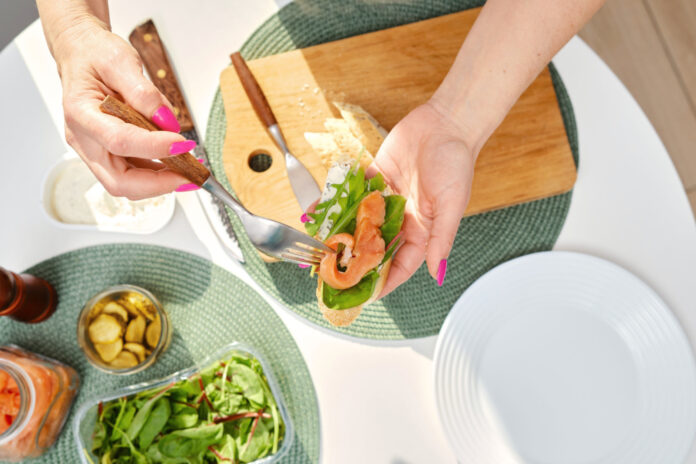Protein-dense snacks are key to feeling full and fueled between meals, especially for the elderly. Healthy snacks for seniors can ensure adequate amounts of protein are being ingested each day.
Protein snacks for elderly are also suitable for a variety of health goals, whether you’re looking to lose a few pounds or put on some weight for your health. Read on to discover the healthiest snacks for seniors, including plant-based options for seniors with veggie-centric diets.
Why Are Protein Snacks for Seniors Important?
Protein is one of the most important nutrients you obtain from food. In fact, it’s one of the main macronutrients you need, along with carbohydrates and fat. In the body, proteins are used for a variety of systems and functions, from transport to immunity to building muscle.
For seniors, meeting the daily protein requirement is vital, not only to maintain muscle mass but to support overall health and wellness. In fact, one study cites it as a key factor of promoting independent living in elderly adults.
Since protein foods can fill you up fast, it’s sometimes difficult for seniors to meet their protein requirements during mealtime. A healthy snack can help to fill in the gaps while also curbing cravings for less healthy foods between meals.
How to Select Protein-Dense Snacks
A variety of snacking options can help you meet your daily protein requirement. Both animal and plant-based food choices are protein sources in the diet. However, it’s recommended to lean towards lean protein sources, since they tend to be more nutrient-rich.
Animal Proteins
Many people still picture a nice, juicy steak on a plate when they think of the word protein. Animal-based proteins are plentiful with nutrients, and generally contain higher levels of iron, some B-vitamins, and zinc than plant-based proteins do. This is why cutting meat or animal-based proteins out of the diet can be dangerous if meals aren’t carefully planned or supplements aren’t considered to “fill the gaps” in nutrient needs.
However, animal proteins are typically higher in calories and saturated fats, both of which can be harmful in the long run when consumed in excessive amounts. For this reason, lean meats (like poultry, fish, or ground meats) are often recommended. Lean meats tend to be lower in saturated fats and higher in healthy fats, which helps to keep protein and other essential nutrients in the spotlight.
When searching for lean, animal-based proteins, seek out the following sources:
- Dairy
- Eggs
- Ground meats (like ground beef or ground pork)
- Poultry (like chicken or turkey)
- Seafood and fish
Plant-Based Proteins
While their amounts of protein tend to be less than animal-based proteins of similar serving sizes, plant-based proteins are often considered more healthy since they come with a plethora of vitamins, minerals, antioxidants, and other healthful nutrients. They’re also well-loved for balancing blood sugar, thanks to the fiber that often accompanies plant-based proteins.
Popular picks when it comes to plant-based protein include:
- Beans and peas (like chickpeas)
- Lentils
- Nuts
- Seeds
- Soy products (like tofu and tempeh)
Meat-Based Snack Ideas
Don’t limit your meat to mealtimes! Instead, vary your protein routine with the following animal-based options.
Beef Jerky
Often considered a classic road-trip snack, beef jerky need not be limited to on-the-go occasions. With nearly 9 grams of protein per 1 oz, beef jerky is a protein-packed snack that can fit in your pocket.
Keep in mind that seniors with digestive discomfort or dental issues may want to steer clear— this chewy snack can be hard on the teeth, jaw, and stomach if consumed too regularly. It’s also recommended to seek out varieties with low levels of added sugar or salt.
Mini Meatballs
Mini meatballs are another great option for a quick, protein-rich snack. Most meatballs are made with ground beef, pork, turkey, or chicken, making them a leaner source of animal protein.
While the amount of protein can vary from brand to brand, most pre-made mini meatballs contain about 8-10 grams of protein per serving. Making them at home is also an option, and can allow you to boost whole grain and protein levels by sneaking ingredients like quinoa or oats.
Deli Meat Pinwheels
If you’re looking for a quick mini-meal or snack, it doesn’t get much better than pinwheels. They are made by layering similar ingredients you would use to make a sandwich on top of a tortilla, then rolling the tortilla up and cutting the “log” into equally sized segments. It sounds complicated, but is easy to get the hang of. Most recipes can be made in minutes, and the finished product makes a pinwheel pattern (hence, the name).
When choosing among deli meats, asking for fresh at the deli counter is almost always a healthier option than opting for pre-packaged. Deli counter meats tend to be fresh-cut, while packaged deli meat tends to be more highly processed. Plus, it’s often higher in sodium, fat, preservatives, and added nitrites.
Look for lean meats like fresh-sliced baked turkey or chicken, and for reduced levels of sodium and fat. Also, it’s often healthier to purchase deli meats without added rubs or seasonings, since those can add calories and take the focus away from the protein content. If all the options seem confusing, you can always ask at the deli counter for help finding what you’re looking for.
Seafood Snack Ideas
Seafood is another animal-based protein often limited to meals. Sneak protein into your snacks by adding some fishy (in a good way) flavors.
Shrimp Cocktail
Why wait until your next party to feel fancy? Shrimp are surprisingly high in protein, with a 3 oz serving providing nearly 17 grams of protein and staying under 100 calories.
The accompanying shrimp cocktail sauce is where added sugars and salts can sneak in. Make your own sauce at home to help keep the focus on healthful ingredients.
Tuna Salad on Crackers
As far as filling snacks go, tuna salad ranks at the top of the list. It provides around 150 calories to keep you fueled, and offers about 14 grams of protein per 3-ounce serving. Pump up the protein by serving tuna salad on whole grain crackers.
Smoked Salmon on Toast
Elevate your snacktime by serving smoked salmon on a slice of avocado toast or half of a toasted bagel. Alternatively, you can cut half of a bagel into pieces and top it with slivers of smoked salmon to create protein-packed bagel bites. Even when smoked, salmon’s protein content is preserved (lingering right around 17 grams per 3 oz serving).
Dairy-Based Snack Ideas
While many snacks are often categorized as “breakfast foods,” they can make a delicious snack during any hour of the day.
Greek Yogurt Parfait
Greek yogurt contains more protein than regular yogurt, making it the perfect base for a tasty parfait. A 7-ounce container or serving contains approximately 20 grams of protein, which helps to keep you full until your next meal.
To create a parfait, layer yogurt, fresh fruit of your choice, and nut and seed-based granola (with a low level of added sugars) in a bowl or cup.
High-Protein Smoothie
Both cow’s milk and whey protein are naturally high in protein. A high-protein smoothie created with these ingredients can help stave off afternoon caffeine or sugar cravings.
Plus, it’s easy to make your smoothie plant-based by adding a tablespoon or two of peanut butter, and using soy milk and plant-based protein powder instead of animal-based ingredients.
Cottage Cheese Bowl
Another breakfast food that can be enjoyed nearly any time of day is cottage cheese. It not only has a unique texture and flavor, but a 4 oz portion contains 12.5 grams of protein.
Create a cottage cheese bowl with fresh fruit (like melons, pineapple, or berries), sliced nuts, and a drizzle of honey for sweetness.
Cheese, Nut & Fruit Combo
String cheese isn’t just for kids! Like other types of dairy, cheese provides plenty of protein in every bite. From stringed cheese to cheese cubes to cheese sticks, the possibilities are nearly endless! Combine with nuts, seeds, or fruit for a balanced, protein-packed snack,
Plant-Based Snack Ideas
One myth that’s often believed is that plants don’t provide much protein. These snacks help to bust that myth by giving several grams of protein per serving, along with other needed nutrients.
Apple Slices & Nut Butter
Although it’s often served alongside a sandwich for lunch, apples and nut butter is a combo that can be enjoyed on its own! Nut butters are a concentrated form of protein, with a single tablespoon of peanut butter providing around 4 grams of protein. However, it’s easy to overdo it since there’s about 100 calories per tablespoon of peanut butter, too.
To keep your snack protein-focused, measure out about 2 tablespoons of nut butter to accompany your apple slices. Alternatively, try apple nachos instead! They are a but messier, but since the nut butter is drizzled as a topping, it’s easier to keep portion sizes under control.
Almonds & Hard-Boiled Eggs
Nuts also provide healthy fats and fiber, which work along with protein to keep you feeling full. Eggs—encouraged as part of a balanced diet and allowed under a lacto-ovo vegetarian eating pattern—also pack in the protein, and even contain all nine essential amino acids you must obtain from the diet.
To capitalize on the nutrition in these protein-rich foods, eat ¼ cup of almonds (about 7 grams of protein) with two hard-boiled eggs (about 12 grams of protein).
Ants on a Log
Making snacks with your grandkids? “Ants on a Log” is a classic, protein-packed snack enjoyed by adults and kids alike. Simply fill celery sticks with peanut butter and then top with a couple of raisins in a line.
Hummus with Veggies or Whole-Wheat Pretzels
Most dips get a bad rap for being high in calories, fats, or sweeteners. Hummus, created from chickpeas, is a welcome exception. It’s creamy texture makes it a great companion to carrots or whole-wheat pretzels.
Plus, just 6 tablespoons counts as a 1 oz protein equivalent to help you meet your daily protein needs. For a twist on the original recipe, use roasted chickpeas for added flavor.
Protein Bars
It may go without saying, but protein bars are also a great snack if you’re looking to up your protein intake. They are a great option for seniors short on time, or those with limited kitchen skills or abilities.
Many store-bought brands are high in added sugar, so you’ll want to carefully inspect the label, weigh the pros and cons based on your lifestyle goals, and bake homemade bars if able.
Tips to Prepare Protein Snacks for Seniors
Protein snacks don’t have to take a lot of time to be nourishing. The following tips can help you assemble protein snacks in minutes:
- Buy nuts, seeds, and/or granola in bulk to save time and money
- Cook snacks (like mini meatballs) in batches and freeze excess for later
- Make a big batch of some snacks (like tuna salad) at the start of the week, then utilize in meals (like sandwiches) and snacks all week long
- Look for individual yogurt or nut butter cups so you don’t have to measure serving sizes each time (beware of added sugars)
- Purchase pre-chopped veggies to save on time and create quick protein snack combinations
- Utilize bento boxes to pre-make high-protein snacks for the week
The Bottom Line on Healthy, High-Protein Snacks for Seniors
Snacks with high amounts of protein are a great way to bridge nutritional gaps between meals. While both animal and plant-based proteins are an option, in any case, it’s important to opt for lean protein whenever possible.
Create filling and fueling snacks by using foods high in quality carbohydrates, fiber, and healthy fats to accompany protein.
References:
Beasley JM, Deierlein AL, Morland KB, Granieri EC, Spark A. Is meeting the recommended dietary allowance (RDA) for protein related to body composition among older adults?: Results from the Cardiovascular Health of Seniors and Built Environment Study. J Nutr Health Aging. 2016;20:790-796.
U.S. Department of Agriculture. Cheese, cottage, creamed, large or small curd. Fdc.nal.usda.gov. Published April 2019.
U.S. Department of Agriculture. Crustaceans, shrimp, raw. Fdc.nal.usda.gov. Published April 2019.
U.S. Department of Agriculture. Fish, salmon, Atlantic, wild, raw. Fdc.nal.usda.gov. Published April 2019.
U.S. Department of Agriculture. Fish, tuna salad. Fdc.nal.usda.gov. Published April 2019.
U.S. Department of Agriculture. Protein foods. Myplate.gov. Accessed July 2023.
U.S. Department of Agriculture. Snacks, beef jerky, chopped and formed. Fdc.nal.usda.gov. Published April 2019.
U.S. Department of Agriculture. Yogurt, Greek, plain, lowfat. Fdc.nal.usda.gov. Published April 2019.






